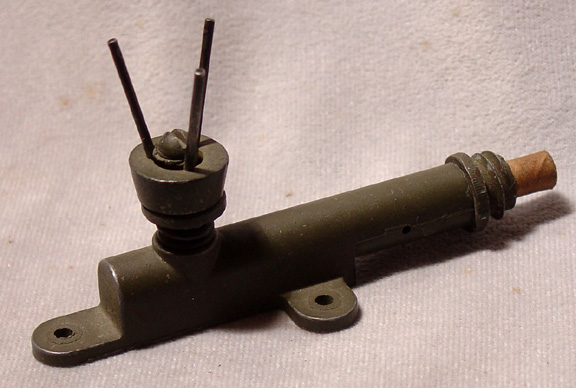Home / Shop
Firing Device, Pressure, M1A1 (Post War Issue)


- Description
- Specifications
In 1943 The A. C. Gilbert Co. modified the M1 pressure Firing Device to add a three pronged adapter to the pressure head. The three pronged head was copied from a German mine igniter and allowed better camouflage for the device. The modifications were minor and were done quickly.
The device consists of a body, pressure head and base coupler. The body is die cast zinc alloy made in a single piece. It has a basically tubular body with a flattened base for about half the length. Protruding out from the base are three tabs that are used to fasten the device in place. A hole in the top of the body fits the pressure head. The striker which has a firing pin head at one end and a groove in the shaft at the other fits with the striker spring inside the body. The pressure head has a flat top with a shaft on the bottom and a threaded hole in the top. There is a keyhole in the lower portion of the shaft. The base coupler is the standard M1 base coupler.
When assembled, the striker and spring are put into the body and forced into the body so that the shaft of the striker fits into a small hole in the back that connects with the hole in the top of the body. The pressure head with spring are pushed down so the shaft of the striker fits through the large upper hole in the keyhole. Once the shaft of the striker is pushed through the pressure head is released so that the small portion of the keyhole engages in the groove in the striker shaft. This holds the striker back in the cocked position. A safety clip fits over the spring on the pressure head preventing its downward movement. A positive safety pin is fitted through holes in the side of the body in front of the striker.
The device is supplied with an extension rod and three pronged adapter. The rod consists of a length of threaded rod and an internally threaded tube. The three pronged adapter has a base with three wire prongs attached by a bolt to the top. The adapter can be screwed directly onto the pressure head or can be attached to the extension rod which is then screwed onto the pressure head.
When laid and the safety pin and clip are removed, a pressure of 20 pounds or more will cause the pressure head to move down bringing the large end of the keyhole in line with the striker shaft disengaging it from the striker groove. This allows the striker spring to reassert itself and push the striker forward until it strikes the percussion cap in the base coupler. The cap fires and initiates the detonator attached to the base coupler and in turn the main charge.
In 1943 The A. C. Gilbert Co. modified the M1 pressure Firing Device to add a three pronged adapter to the pressure head. The three pronged head was copied from a German mine igniter and allowed better camouflage for the device. The modifications were minor and were done quickly.
The device consists of a body, pressure head and base coupler. The body is die cast zinc alloy made in a single piece. It has a basically tubular body with a flattened base for about half the length. Protruding out from the base are three tabs that are used to fasten the device in place. A hole in the top of the body fits the pressure head. The striker which has a firing pin head at one end and a groove in the shaft at the other fits with the striker spring inside the body. The pressure head has a flat top with a shaft on the bottom and a threaded hole in the top. There is a keyhole in the lower portion of the shaft. The base coupler is the standard M1 base coupler.
When assembled, the striker and spring are put into the body and forced into the body so that the shaft of the striker fits into a small hole in the back that connects with the hole in the top of the body. The pressure head with spring are pushed down so the shaft of the striker fits through the large upper hole in the keyhole. Once the shaft of the striker is pushed through the pressure head is released so that the small portion of the keyhole engages in the groove in the striker shaft. This holds the striker back in the cocked position. A safety clip fits over the spring on the pressure head preventing its downward movement. A positive safety pin is fitted through holes in the side of the body in front of the striker.
The device is supplied with an extension rod and three pronged adapter. The rod consists of a length of threaded rod and an internally threaded tube. The three pronged adapter has a base with three wire prongs attached by a bolt to the top. The adapter can be screwed directly onto the pressure head or can be attached to the extension rod which is then screwed onto the pressure head.
When laid and the safety pin and clip are removed, a pressure of 20 pounds or more will cause the pressure head to move down bringing the large end of the keyhole in line with the striker shaft disengaging it from the striker groove. This allows the striker spring to reassert itself and push the striker forward until it strikes the percussion cap in the base coupler. The cap fires and initiates the detonator attached to the base coupler and in turn the main charge.